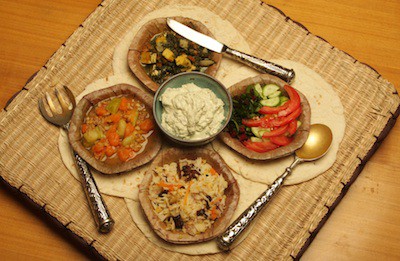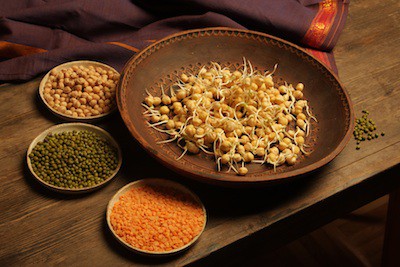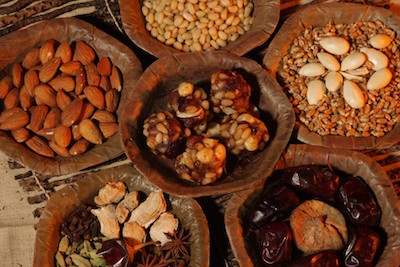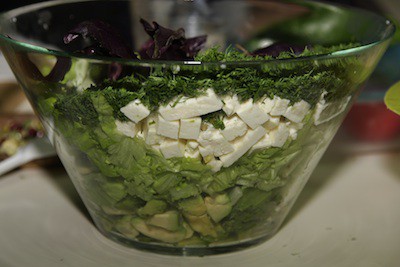Mikhail Baranov: Yogic diet in moderate climate

The aim of hatha yoga as one of the stages on the way to the apogees of raja-yoga is conquering the universal vital energy, Prana. Prana exists everywhere, manifesting itself in different forms and nature. Filling and penetrating all the living and nonliving matter, it unites body, mind and spirit. Prana can be obtained from atmosphere and from food.
Correct everyday practice of shatkarmas, asanas and pranayama trains and increases the organism’s ability to consume, process and accumulate Prana. It is especially important in big modern cities, where various ecological and social factors (environmental pollution, population density, information overflow) lead to faster contamination of the body structure and increased energy demands.
Hardly any yoga practitioners are able to soak the vital amount of Prana only from the air and sunlight. Food still remains the main energy source for the large majority. A person who starts his or her regular and intensive practice soon realizes the fact that many of his or her old habits stultify the effect. As a result, a practitioner feels the necessity to replace them with the ones that would support and maintain the new state. The same refers to the eating habits. Striving for eutrophy is a characteristic of starting practitioners, as well as advanced ones. It is important to highlight the difference between striving and a real necessity. The necessity of change arises from the conditions that we create, when we induce our development or setback. Striving, like imagination, is based on the idea that we can start “living a better life” by changing our habits. Yoga diet is inseparable from yoga practice itself and facilitates formation and development of qualities boosting the mind evolution process.
Habits and fixations. Gunas and emotions.
The mind is not only reason and intellect, but also an ability to feel and to perceive. The mind, which perceives the apartness of itself, is called Ahamkara in the Indian tradition.
As Ahamkara roots itself in a body, it can forget about its real, essential nature, identifying itself with the fake self, the personality consisting of a number of habits and automatic reactions. Indulging in playing with sensual pleasures supports contact with only physical body. Habits and fixations are caused by attachments to some particular states of psyche and body. Therefore, everything that supports habitual sets and patterns of perception is accepted on subconscious level.
Every kind of food affects our mind one way or another. For instance, consuming suscitating alimentary stimulators, like sugar, coffee, chocolate, some spices etc., may cause the illusion of prosperity and “abundant life”. As a strong stimulator, sugar brings an immediate satisfaction to Ahamkara and temporarily neutralizes sharp psyche fluctuations. Attachment to sweets often arises as a compensation for the bitterness of frustration, the feeling of dissatisfaction. As a result of the biochemical impact of food we become more hectic or passive, concentrated or dissipated. It changes our condition and perception. Food, of course, is not the sole or the primary factor, but it is definitely a constant one. A conscious choice of food and dietary regimen helps to form a stable psycho-emotional background, which is beneficial for practicing yoga. It is necessary to remember, that all fixations are temporary and they disappear as we broaden our limited perception, inherent in our personality in mundane life.
Depending on the impact on the mind, the qualities of food can be divided into three categories, called gunas.
Tamas – potential energy waves. It represents inertness in the mind. The predominance of Tamas causes the lack of activity and weakens the differentiating ability.
Rajas-kinetic energy waves. It represents motion. In this state excessive psychic activity weakens the differentiating ability.
Sattva– balance. Harmonious state of mind, which enables the mind to differentiate correctly.
Tamas presupposes darkness, inability to perceive, ignorance and fear of a lethargic mind. Tamas manifests itself as restraint, laziness and dumbness, submitting the mind to outer or subconscious forces. Tamas is the passive state of mind, “drifting on the waves of dreaming”, the slumber of reason, instinctive element.
Excess of Rajas creates anxiety, dissatisfaction with the present, excitement of mind in the pursuit of pleasures and a passionate thirst for desires. Rage, obstinacy, aspiration for power are emotional manifests of Rajas. Tamas and Rajas are necessary in the nature and they are mutually compensating. The energy and vitality of Rajas is balanced by the stability and constancy of Tamas forms.
Sattva arises when Rajas and Tamas are balanced. Sattva is a quality that enables Ahamkara to express itself creatively with the help of mind and senses. Sattva means clearness, literary, something of the same nature as the Truth (Sat). The sattvic state is a state of a clear understanding, balanced and uncluttered perception. Developing this quality helps to gain control over the mind’s rajastic or tamasic impulses.
Sattvic diet.

“The most favorable food for a yoga practitioner: good grains, wheat, rice, barley, milk, clarified butter, brown sugar, crystallized sugar, honey, dried ginger, payola, five vegetables (ocal vegetables), beans (and other legumes) and pure water.
A yogi should take nutritive and sweet food, mixed with clarified butter and milk; it should nourish dhata (the main components of the body) be pleasant and appropriate.”
(Hatha Yoga Pradipika, 1.62-63)
The ingredients listed in sloka 62 possess one and the same quality: they refer to sattvic food. Apart from this, these things nutritious and tasty. It is important to like the food that makes up your new diet, that is why you shouldn’t refuse from the viands you are used to until you find a proper substitute for them. Food’s main responsibility is to nourish dhatu, all tissues and components of the body, creating favourable conditions for development of mind (the mental body) and spirit (the causal body).
Sattvic food is called mitahara. Sattva bears qualities of purity, lightness, tranquility and harmony. The sattvic diet is originally intended for yoga practice with the aim of perfection of consciousness. Its balancing effect on the state of mind also helps in treatment of mental disturbance. Sattva facilitates the unity of mind, body and spirit. Sweet food increases Sattva guna, but it does not presuppose abundance of sugar. Natural sweetness is found in grains and fruits, some vegetables and dairy products. Its qualities are described in another established text on hatha yoga, “Gheranda Samhita”: “Sweet taste has the same nature as the human body. Its tissues have the same sweet taste that is why it facilitates the growth of all tissues of the body and Ojas.”
Helping to achieve longevity, sweet taste soothes the five senses and the mind, brings strength and healthy complexion. It is nutritious, revitalizing, fulfilling; it makes the body stronger and heavier. In other words, it saturates an organism, facilitating the renewal and regeneration of tissues. Energetically sweet taste is cooling, moist and heavy, and its adequate digestion requires a strong Agni – digesting fire. An intensive practice of asanas and pranayamas provokes a substantial increase of Agni, which, in the amounts exceeding those necessary for processing Ama (slags) is likely to cause an organism to use the tissue reserves, that can “dry out” the organism. In this case, moistening, cooling and nutritious qualities of food are necessary for keeping balance in the body.
Sattvic diet includes only pure food, abundant in vital power (Prana). Any kind of food, which is connected with killing is forbidden. Though fish and meat have sweet taste, the energy they bring activates instinctive programs, inducing a mind to Rajas and Tamas. Viands grown in infected environment, or with the help of excessive fertilizers and genetically modified foods are undesirable. Sattvic eating also means a balanced diet, it is not recommended to eat too much or too little. Malnourishment is a way towards exhaustion, it leads to the weakness of a body and infirmity. On the other hand, digesting excessive food draws energy from other centres, as a result, generating Ama from undigested food. The ideal proportion, described in “Pradipika” is achieved when half of the stomach is filled with food, one quarter is allocated to water and the other – to air. Overeating even the most sattvic food submerges the eater in Tamas.
Sattvic food is originally intended for revealing a mind, so in case of a very active lifestyle or intensive physical exercise it can be insufficiently nutritious for the body, especially for Vata body type.
Food of different qualities and tastes affects doshas in different ways, so it is necessary to consider the individual body type while making up a diet. Balance in body and mind is an integrated process. In addition to the qualities and ingredients of food, we should also take into account the state of mind at the moment of cooking and eating.
Receiving the necessary amount of pure water is another point, which is important for adequate purification and functioning of the organism. The quantity is individual, but the minimum is a glass of raw spring (or well-filtered) water in the morning (fasted), a portion before every meal and a glass before bedtime. Warm water is desirable in cold weather and cool water is the best for hot time. Tea, stewed fruit, fruit juice and other liquids cannot be a valid substitute for pure water, as they are digested as food, provoking gastric juice secretion.
Strategic food for a yogi in moderate climate.
On the basis of everything mentioned above, let us briefly regard the viands that represent the most suitable food for a hatha yoga practitioner in moderate (European) climate. The products are listed from highest content of Sattva to lowest. It includes the food available in our region or suitable substitutes.
Fruits
Fruits are sattvic in their essence and easy to digest. They can be used without limitation, both local fruits and berries and imported ones, during the corresponding season. Fruit should be consumed fresh or squeezed (fresh juices). Sometimes they can also be baked. Fruit that cannot claim immaculate freshness are tamasic and in too sugary jams and confitures they gain the qualities of Rajas. Besides, heat-treating destroys the majority of vitamins. Jam can be replaced with dried fruit (steeped or eaten with tea). All dried berries are good to make berry infusions (mors), just by adding boiling water and infusing in a thermos. Brown reed or palm sugar, recommended in “Pradipika” is hard to find, and refined sugar should definitely be replaced by honey.
Vegetables
Vegetables contain less sattva than fruits and they are also heavier. However, it is good to use all sweet and not pungent vegetables, such as cucumbers, pumpkin, carrots, beetroot, celery, marrows, turnip, tomatoes, eggplants etc. Potatoes and gumbo refer to heavier vegetables. Sattva is present in salads (not pungent sorts), green top, potherbs, including wild potherbs, like aisle-weed, plantain and nettles. Herbs purify blood and contain a lot of micronutrients. Cabbage (in excessive amounts) is rajastic and furthers bloat, which is, however, possible to prevent by stewing cabbage with ghee. Sour cabbage, radish, hot pepper, onions and garlic are rajastic and tamasic. All other vegetables, fresh, baked or steam-cooked, are favorable for the diet.
Crops
Grains represent the basis of a sattvic diet. The most sattvic grain is rice. It is better to use brown, black or basmati rice, because after slotting, polishing and steaming rice loses not only its bran coat, but also some healthy substances (here basmati rice can be a positive exclusion, because preliminary scalding saves some substances by moving them to the centre of the grain). Kichari - a dish made of hulled mung bean and basmati rice – is one of the basic meals in a yogic ratio. Is good after shankh prakshalana (alimentary tract lavement in hatha yoga), as well as the base of mono diet in Ayurveda, in the course of purifying therapy and recuperation.
Sprouted wheat is a super grain. It is abundant in vitamins and micronutrients, and is especially suitable for our climate. It nourishes the body, literary charging it with energy, revives after illnesses and physical exercise. However to some people it can seem a bit heavy if consumed raw. This can be avoided if you use it in smaller amounts and chew thoroughly (a couple of tablespoons warmed in ghee, with some honey) or as flat cakes (that are tastier and easier to digest). Rye (sometimes, oats and barley) can be cooked in the same way, but technically it is harder because the crude bran coat is not removed.
Oats is the protein champion among the grains (of course, wholegrain oats, and not muesli). The nutritive and smothering properties of oats have been profitably employed in case of Agni excess (f.e. allergy to milk). Buckwheat, barley, millet and corn are favorable, too, though not so frequently used.
Bakery products made from white flour, received from a coatless grain without the bud and Prana are undesirable. Wholegrain bread is more suitable, especially if no yeast is used (it is considered that thermophilic yeast suppress the microflora). Such bread can be bought in supermarkets in large cities. Coarse flour bannocks cooked like the Indian chapatti can make a good alternative to traditional bread, if you find some time to cook them.
Legumes

Legumes are a perfect source of protein. However they are quite a heavy food and also cause bloat. Tofu (soya cheese, derived by way of fermentation) and mung beans are a positive exclusion. Then, from lightest to heaviest, follow red lentils, small green lentils, large lentils and chickpea. Their heavier relatives are small and white beans, red beans, peas, Bengal beans. Preliminary steeping and especially sprouting and debranning, however, reduce the explosive risk. Adding spices also helps.
Soya flour products (“chicken-flavour” etc.), soya milk (“fortified”), mayonnaise, chocolate and mushroom soya pastes and the like, usually contain a lot of preservatives, excessive amounts of salt and spices, and therefore, do not inspire much confidence in their healthiness. Tofu can be too hard and heavy to digest, if the technology of production is violated or neglected. Such tofu is sometimes called “soya cheese”. But the real quality tofu is well-fermented, soft and delicate.
It takes about 24 hours to sprout mung beans and chickpea. Before spouting they should be steeped in warm water for 4 hours and after it they can be kept in refrigerator for up to 4-5 days.
Nuts

Seeds and nuts represent a valuable component of the ration and have a sattvic nature. They should be eaten fresh or steeped. They can also be slightly roasted, but mind that over roasted and salted nuts lose their healthy qualities and develop Tamas. They are quite stodgy and it is better to eat them as a separate dish, however, you can eat them with rich and green vegetables and dried fruit. They are digested well if you drink them as cocktails (nuts are steeped, peeled, ground and thoroughly mixed with water in a blender). Of all the nuts, which are available in our climate, almonds and pine-nuts are the best. Then follow cashew, walnuts, filbert, brazil nut, hazelnut, as well as pumpkin, sunflower and apricot seeds. Nuts are nutritious and contain a lot of oils, that is why their calefacient qualities are very good for a cold climate.
Dairy products
A yogi should bear especially warm feelings for cooling dairy products. By far the most sattvic dairy is fresh milk, taken from a good and healthy cow (or goat) that escaped taking any antibiotics or combined feed, unless the milk is boiled, pasteurized or homogenized. After processing, milk develops tamasic qualities and fosters Ama. Allergy to factory-made is often caused by the antibiotics that are given to the cows. It is also doubtful that fortification with vitamins makes milk healthier. Cultured milk foods are much easier. They have a longer shelf-life, and are digested easier due to the presence of various strains and bifid bacteria. However, they are less sattvic, and can even gain tamasic qualities in case of riot growth of bacteria and souring. Home-made dairies are always more preferable, but among those, which are on offer in the shops, quality products without milk-powder should be chosen. Any natural home-made unsalted cheeses, like pannier, or Adygei cheese (the salted sorts, like suluguni or sheep cheese can be previously steeped), as well as fresh curd, are also good in moderate amounts. Hard cheeses, which involve ferments from animals’ stomachs, are very heavy, and the fancy blue cheeses are a perfect dose of Tamas.
The best of fats is ghee, or clarified butter. Its numerous nutritious and medical qualities are praised in yoga and Ayurveda treatises. Usual butter is less suitable, as the factory-made butter contains additives, which are eliminated when it is rendered. What concerns cream and sour cream, these dairies are not so favorable.
Milk should be a separate meal. The best way to have it, is to drink it separately, or adding some ghee, honey or spices. Honey and spices, such as saffron, ginger, cardamom, cinnamon and cloves improve the digestion of milk, removing excessive Kapha. Also you should mind that a human body seldom fully digests more than 350 ml of milk at a time.
Oils
Most oils are rather heavy and are not desirable in large amounts. However, ghee can be added to various dishes without limitation. Sesame and coconut oils are sattvic, as well as unrefined olive oil, flax and sunflower oils. Pumpkin, cedar, walnut, hemp-seed and dodder oils, as well as oil from sprouted wheat have a very high level of nutritious and medicinal properties.
Sweets
Honey and raw palm sugar are sattvic in temperate amounts. All refined sugars, as well as sugar-containing foods are not recommended. Honey, in its turn, shouldn’t be heated; otherwise, it becomes toxic and develops Tamas.
Spices
Sattvic spices are ginger, cardamom, cinnamon, fennel, coriander, turmeric (haldi). Others are mostly rajastic. They can however be used moderately, when Rajas is supposed to balance Tamas, increasing Sattva indirectly. Salt should be minimized, and among different salts, sea salt is preferred.
Drinks
Pure spring water, infused herbs (sattvic ones) are the best. Any local herbs can be used if you are sure about their positive effects. Different sorts of green tea and mate are sattvic in moderate amounts and are considered to activate your mind. Black tea is a heavier and stronger stimulant.
The main rules of yoga eating

• Eat mainly sattvic food
• Spare the maximum of Prana, when you cook. For this reason, your food should be simple, minimally heated, without excessive sophistication and involving not more than two operations in cooking. Simple does not mean primitive!• Keep your mind balanced when you cook or eat. Following Yama and Niyama, consecrating the food with a mantra while cooking and before eating will help you create and maintain the balance. Watching television, reading, talking, and losing the state of conscious presence are likely to hinder you in doing it.• Be abstemious. Being full is a matter of “how”, rather than “how much”. Your stomach should be not more than half-filled with solids.• Chew thoroughly, so that the food would mix with saliva. Keep to the rule – Eat liquid food and drink solid food. The subtlest elements of Prana are digested in the mouth.• Drink some water before the meal and not during or after. Depending on the amount and ingredients of food, you should not drink one or more hours after the meal, in order not to extinguish the digesting Agni. If the food is dry, it is possible to drink some green tea with it.• Follow the diet, which suits your body type, climate you live in and your regular needs. Do not rush into the extremes of asceticism. Be attentive to the current state and abilities of your body.• Keep a good “inner fire” – Agni. Practicing shatkarmas, asanas and pranayamas is helpful here. Agni is at its strongest in the afternoon, when the sun channel is active. One of the ways to enhance it is breathing through your right nostril. You can open it if you lie down on your left side for a while after eating.• Don’t eat unless hungry. You should also abstain from eating heavy food before going to bed, and avoid eating during two or three hours before you go to sleep.• Consider the combinability of ingredients. Do not mix those which seem too heterogeneous. Different food requires different stomach juices and ferments, it takes different time to be digested too.
• After the meal you shouldn’t start any physical exercise. Intellectual activities are not very effective during the first couple of hours, either.
Be healthy and Bon appetit! :)







